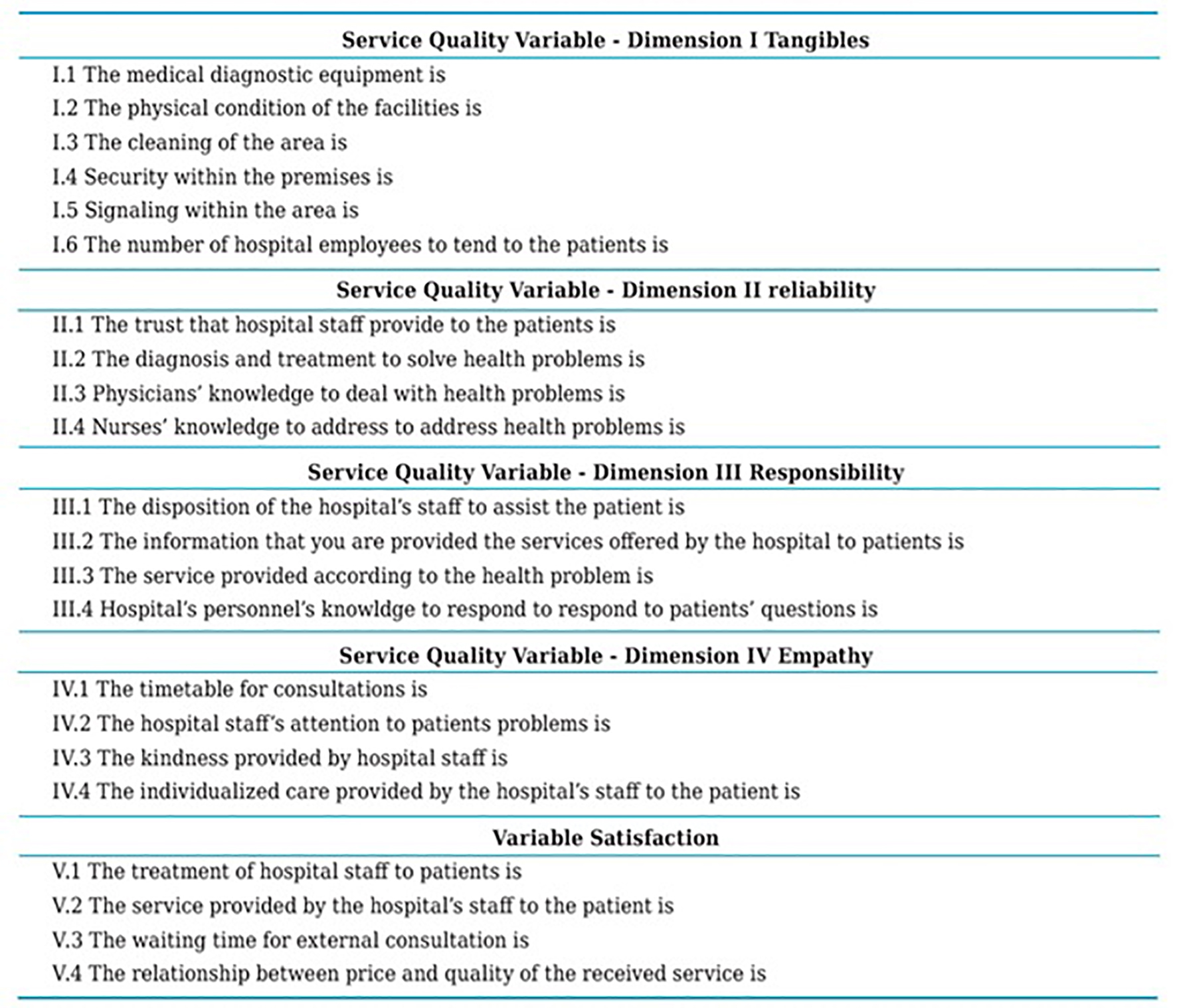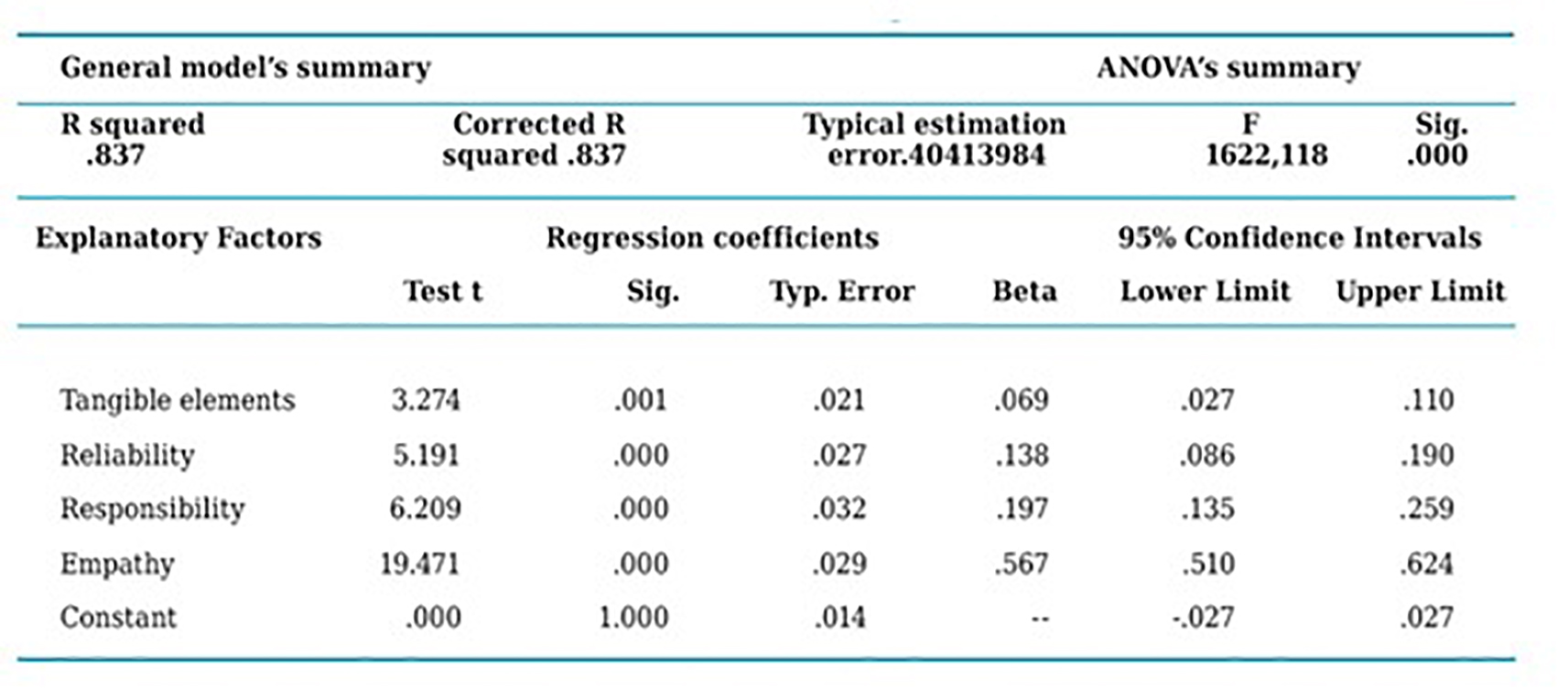1. Introduction
In the last few decades the evaluation of service quality and the satisfaction of the users have become central areas for hospital management. In light of the commercialization of these indicators, they present an important reference for decision-making and designing of policy and administrative strategies. In this sense, the present study is developed, and it has the purpose of determining the perception of the users regarding the services’ quality and their influence on the level of satisfaction, in order to identify factors of success and areas of opportunity that contribute to continuous improvement in the sector’s activities. The document is structured in four sections that describe, in first instance, the theoretical framework that underlies the state of the art on the variables of interest (quality and satisfaction). Subsequently, the methodological design that mentions the approach, the sample, the collection techniques, and the data analysis of this research is detailed. As a third section, the results obtained by each of the study’s questionaires are explained. Finally, the conclusions and recommendations that stand out for the present inquiry are presented.
2. Quality and satisfaction within Mexico’s health system
In Mexico, according to Gutiérrez and Hernández (2013), Knaul, et al. (2013) and O’Shea (2015), health institutions have made significant efforts to ensure universal coverage in health services. However, one important fact to point out is the out-of-pocket1 spending that the Mexican society invests in health, since it is more than twice of what is registered registered in most nations, as noted by the Organization for Economic Co-operation and Development (OECD 2013, 2016) (Graph 1).
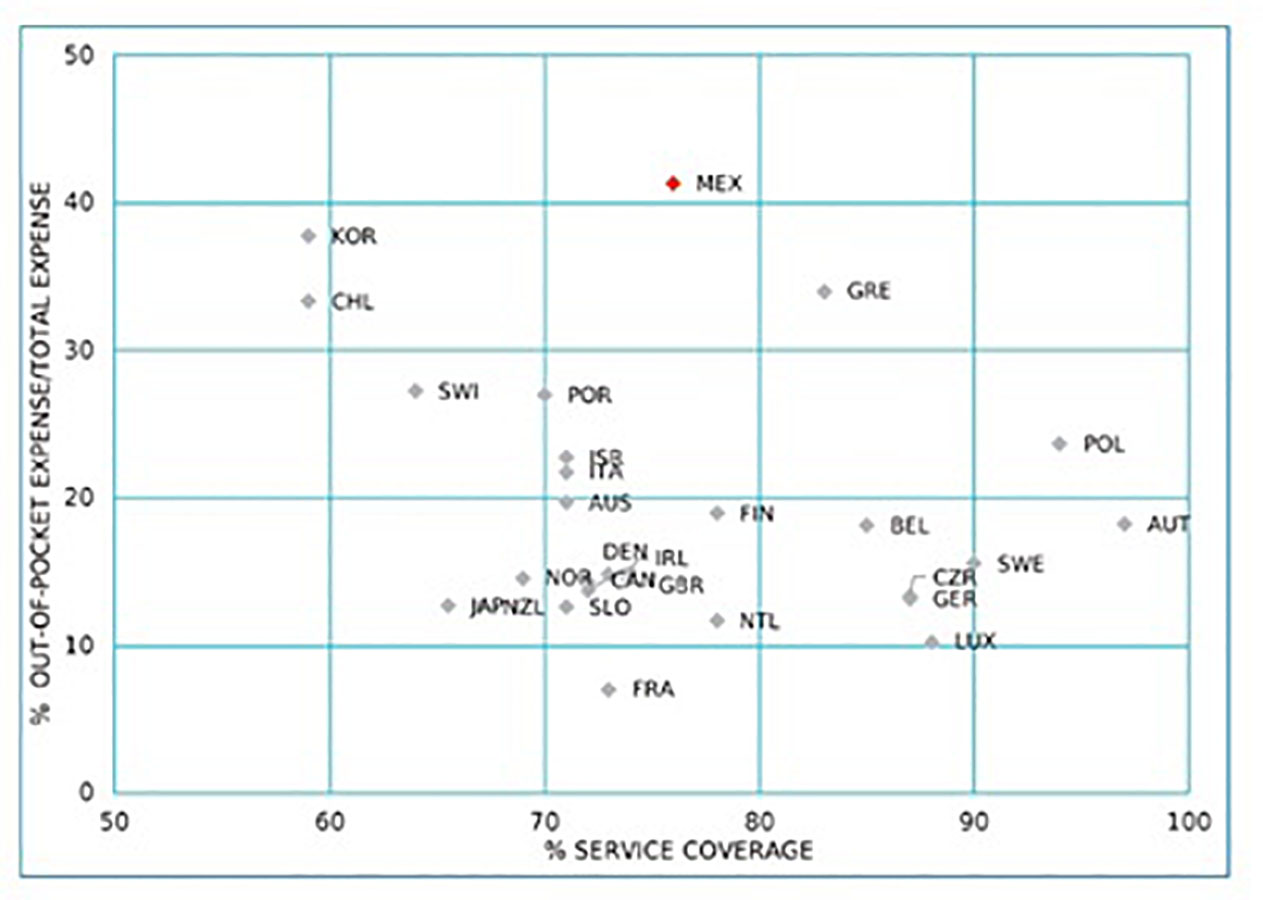
Graph 1 Health coverage compared to the percentage of out-of-pocket spending relative to total health expenditure in OECD countries. Source: Organization for Economic Cooperation and Development (2013).
According to the OECD, this data indicate that in Mexico, people choose to pay for private medical services because they do not have access to public health services or simply perceive a higher quality of medical care in private sector health institutions than in those attached to the public administration. Due to this, Artaza (2015) describes as a fundamental challenge for the health system in this country, to guarantee quality health services to society, since this indicator is considered as “an essential attribute of health care which is essential to achieve National health goals and sustainable future for the health system” (Granados, Tetelboin, Torres, Pineda y Villa, 2011: p. 403).
According to Granados, et al. (2011) and Revilla and Pimentel (2012), in Mexico, initiatives to improve the quality of health services have been carried out since 1956. However, in the new century, the efforts to establish a quality program that takes into account from first-level medical institutions to highly complex hospitals have been most notable due to the implementing of a national strategy that seeks to reach acceptable levels of health services nationwide, and which has been called “Cruzada Nacional por la Calidad de los Servicios de Salud” (National Crusade for Quality of Health Services).
Since the beginning of the National Crusade for the Quality of Health Services, the General Directorate for Quality and Health Education, normative body that regulates the operation of this strategy, monitors it through the “INDICAS” system of indicators that assess hospitals’ performance in the country, such as decent treatment, medical care, technical capacity, service organization, among others (Ruelas, 2015). This finding, according to researchers, represents a success for the health system in Mexico because the systematic and permanent evaluation of quality through patient satisfaction represents an indicator of strategic results that contributes to improving the lending of services (Gogeascoechea, Pavón, Blázquez, Blázquez and Rebatte, 2009; Freitas, Silva, Minamisava, Bezerra and Sousa, 2014; Navarrete, 2015; Fernández, Iglesias, Fombellida, Vicente, Alonso and Mirón, 2016).
Given this scenario, it is important to clarify that quality and satisfaction are related but different concepts. While satisfaction is understood as the actual perception of the people about the performance of goods or services, anticipated by the expectations of the users, service quality is based on the overall assessment over time (Velandia, Ardón and Jara, 2007). In other words, service quality is linked to the long term, while satisfaction is associated with a transient judgment, which may be changed in every transaction (Parasuraman, Zeithaml and Berry, 1988; Carman, 1990; Bolton and Drew, 1991).
Given the confusion that sometimes originates between the concepts of perceived quality and user satisfaction in the health system, it is possible to trigger the presence of a debate among the theorists on the subject, since, coupled with differences and similarities in their conception, there is still no clarity in the literature regarding the direction in the relation of these concepts. For example, there are intermediate postulates which consider that between quality and satisfaction there is a reciprocal causal relationship that depends on the moment the service is evaluated (Iacobucci, Grayson and Ostrom, 1994; McAlexander, Kadenburg and Koeinig, 1994; Dabholkar, 1995).
In contrast, authors such as Carman (1990), Parasuraman, et al. (1988), Bolton and Drew (1991) suggest that satisfaction is an antecedent of perceived quality. While more recent research developed by Correia and Miranda (2010), Amin and Zahora (2013), Kesuma, Hadiwidjojo, Wiagustini and Rohman (2013), Bruwer (2014), Fernández et al. (2016), argue that quality precedes satisfaction, because satisfaction is a more general concept that encompasses, among other aspects, the perception of quality in the service. These statements lead to the conclusion that determining the right direction regarding the relationship between service quality and user satisfaction is still imprecise; however, it should be noted that there is a general consensus that both concepts are highly correlated, which highlights the need to evaluate both components and the influence that is exerted between them.
3. Methodology design
In order to fulfill the research’s objective and considering that the study has two variables of analysis, in the present investigation three main questions have been raised:
What is the perception of the users regarding service quality in the public health sector of the state of Tamaulipas, Mexico?
What is the users’ level of satisfaction in the public health sector of the state of Tamaulipas, Mexico?
How is service quality and users’ satisfaction related in the public health sector of the state of Tamaulipas, Mexico?
In order to answer these research questions, the study was developed under a quantitative approach, through the application of 876 questionnaires to users of eight public hospitals in the state of Tamaulipas, Mexico, in its three levels of attention2. At the request of the authorities and in order to preserve the anonymity of the studied hospital institutions, in this study first level of care hospitals are referred to as APN, ASN, BSN, CSN and DSN are second level hospitals; And ATN, BTN and CTN are third level of care hospitals.
The study’s population is represented by all those people who have access to the health services of the analyzed hospital institutions, who are called patients or users indistinctly.
However, because of the complexity to carry out a probabilistic sampling, it is decided to resort to the non-probabilistic sampling method of volunteer participants (Hernández, Fernández and Baptista, 2010), with the following inclusion criteria:
Persons over 18 years old.
Users from both sexes.
Direct user of the health services offered by the institution.
Having voluntarily agreed to participate in the study.
Patients who were in the waiting room for external consultation, specialty consultation, emergency room, pharmacy, cashier, radio diagnostic studies.
To collect the data, a questionnaire was designed with two sections (Table 1). The first one comprises 18 items, distributed in four dimensions (tangible elements, reliability, responsibility and empathy) to evaluate the service’s quality, taking the basis of the SERVQUAL measurement model as an instrument with a high degree of reliability and which has also been adapted and validated to the health context in previous investigations (Babakus and Mangold, 1992; Kesuma, et al,, 2013; Calixto, Okino, Hayashida, Costa, Trevizan and De Godoy, 2011; Ibarra, Espinoza and Casas, 2014; De la Hoz, 2014).
On the other hand, in terms of the satisfaction variable, indicators based on the INDICAS system of Mexico’s Ministry of Health are taken as the basis for assessing patient satisfaction, since the given measurement parameters represent an important reference at the National level in the health sector by setting the standard on the evaluation of hospitals’ performance across all the institutions of the country. Additionally, an item that analyzes the price / quality ratio is included as an indicator of importance in the patient’s (Betin, Guardela, Infante, Díaz and González, 2009; Vásquez, Arimborgo, Pillhuaman and Vallenas, 2009; Correia and Miranda, 2010).
It is important to note that to ensure the reliability of the applied questionnaire the techniques of exploratory factor analysis (KMO higher than 0.70, sig. 0.000) and the Cronbach Alpha indicator (values higher than .70) were used; this allows to observe the validity of the dimensions that make up the underlying structure of the studied variables (quality and satisfaction) by identifying acceptable values in the assessment.
Having said that, in the data analysis, in order to analyze the relationship of dependence between quality and satisfaction, the multiple linear regression technique was applied additionally to using complementary statistics (descriptive statistics), basically frequency proportion to evaluate the score obtained for each of the studied variables.
4. Results and discussion
4.1. Perception of respondents regarding the quality of public health services
According to the first research question which is “What is the users’ regarding the service’s quality in the public health sector of the state of Tamaulipas, Mexico?” It refers to the quality of the general quality of the services which obtained a general average of 3.74 on a five-point Likert response scale, where 1=Terrible, 2=Poor, 3=Regular, 4=Good and 5=Excellent, which indicates a favorable evaluation by the respondents towards the perception they have regarding the quality of the services provided in the hospital institutions participating in this research, since the obtained score displayed a good perception.
This indicator is reinforced by the frequencies of proportion performed on each of the dimensions that make up the service quality variable (tangible elements, reliability, responsibility and empathy); percentages are shown in Graph 2.
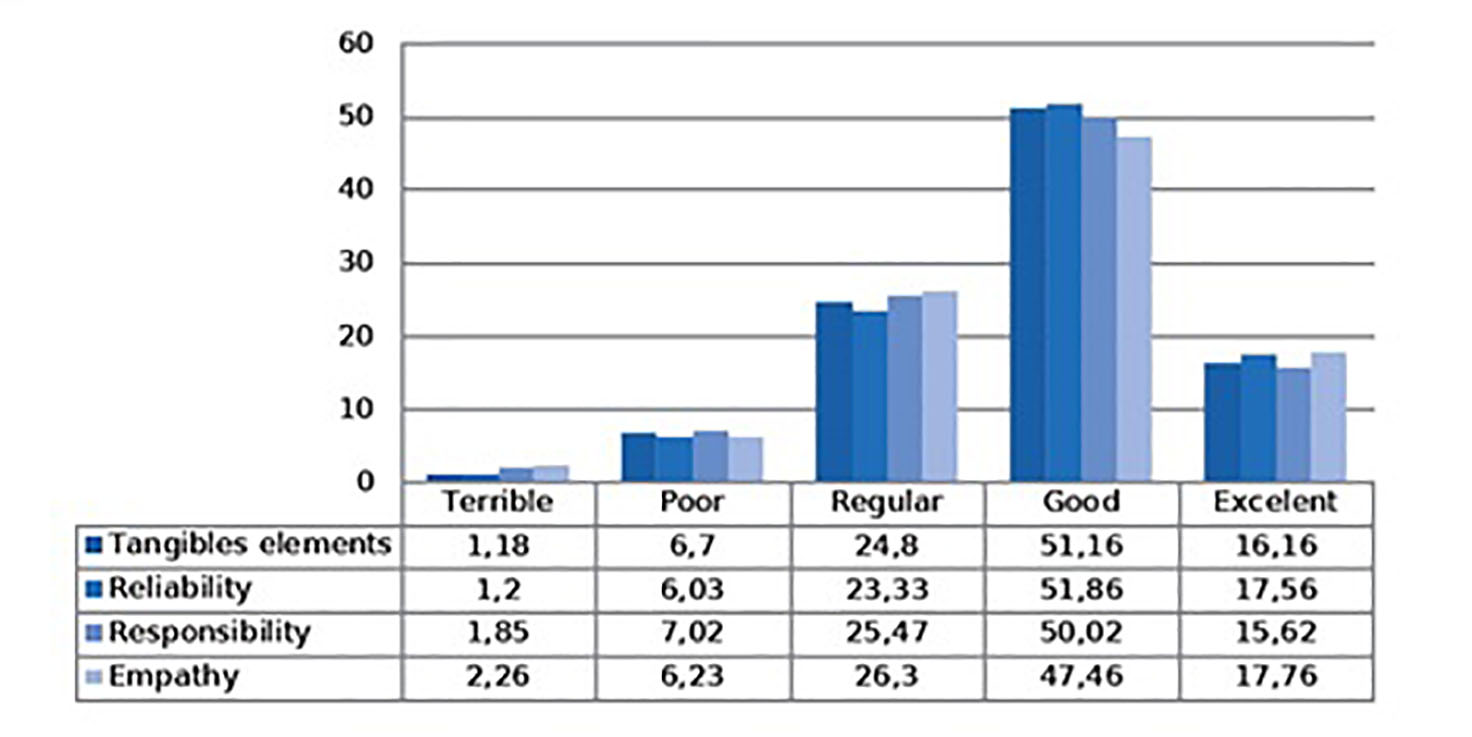
Graph 2 Trend of responses given to the quality factor of health services. Source: Author's own elaboration.
With the analysis of these results, it is possible to indicate that the quality of the services in the hospitals studied is characterized by a good perception from the users surveyed, thereby giving response to the first research question. However, it should be noted that despite the favorable trend in the responses, areas of opportunity were identified so that users’ perceptions improved and managed to be at good or excellent levels. Particularly it is possible to specify that for the factor of tangible elements the elements susceptible of improvement cleaning and the physical state of the facilities, the conditions of the medical diagnostic equipment and the number of employees that tend to the patients in the studied hospitals.
Then, for the reliability factor, the nurses’ knowledge on health problems, as well as the trust that hospital staff provide to patients represent the biggest areas of opportunity in this dimension.
Nevertheless, regarding the liability factor, the items that are identified as opportunities for improvement are the hospital staff willingness to help the as well as the information provided about the services offered by the hospital and, regarding to the empathy factor, the schedules that the hospitals have to tend to users. Also, the staff’s kindness towards the patients is an item with the highest nonconformity level by the respondants.
4.2. Users’ Satisfaction in the public health sector
Regarding the second question of this research that is “What is the users’ level of satisfaction in the public health sector of the state of Tamaulipas, Mexico?” It is mentioned that it was possible to obtain an overall mean of 3.58 for the satisfaction variable thereby positioning its value in a perception close to good, very similar to the score reached by the variable of quality of the services, given the opinions of the respondents are inclined towards favorable assessments in both study variables.
Specifically, Graph 3 presents the frequency of the responses given to each of the items that make up the satisfaction variable, whose average responses are distributed in 59.52% for values 4 and 5 that refer to levels of satisfaction from good to excellent, while 12.25% of respondents show levels of satisfaction between terrible and poor, and the remaining 28.27% indicates a regular level of satisfaction with regard to the items which evaluate this factor of analysis.
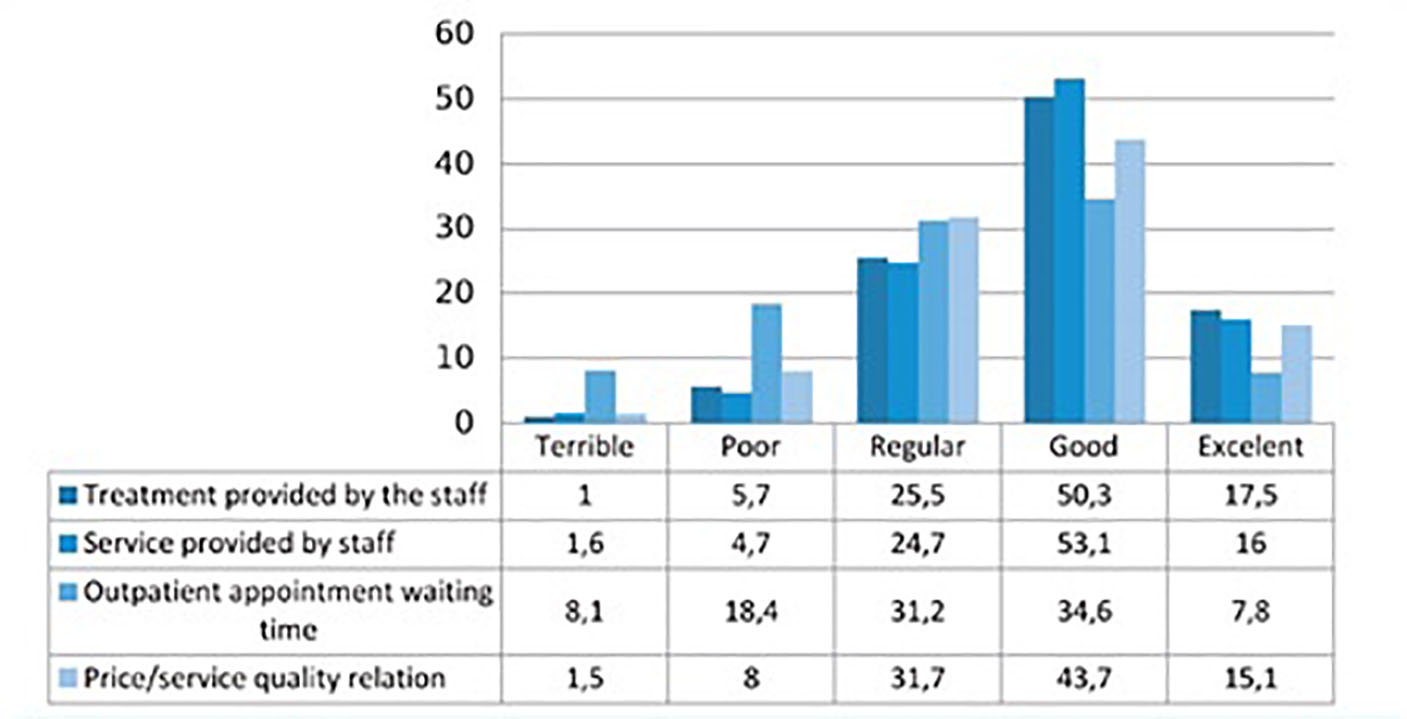
Graph 3 Trend of responses given to the user satisfaction variable. Source: Author's own elaboration.
With these results, the responses’ frequency indicates that the users show a good level of satisfaction with the health services received from the hospitals analyzed, thus giving response to the second research question.
However, as in the variable of service quality, the analysis of satisfaction also identified important elements that could be improved. For example, the waiting times for an external consultation represent the main area of opportunity identified in the study, since on average the trend of responses given to this statement shows a significant 57.7% of users who rate it as a terrible regulator of satisfaction levels.
This finding is probably related to the item of quality that refers to the number of employees that tend to the patients, which was also identified as an area of opportunity for the studied hospitals in this research; thus leading to the conclusion that because of the lack of staff, the waiting time to take care of the patients increases.
4.3. Service quality and their relationship with the satisfaction of users in the public health sector
Derived from the theoretical exposition and the aforementioned results, Figure 1 proposes the integration of the concepts of quality and satisfaction through the conceptual model of the relationships expected among between these study’s variables, understanding that the factors of quality are components that precede the satisfaction of the users.
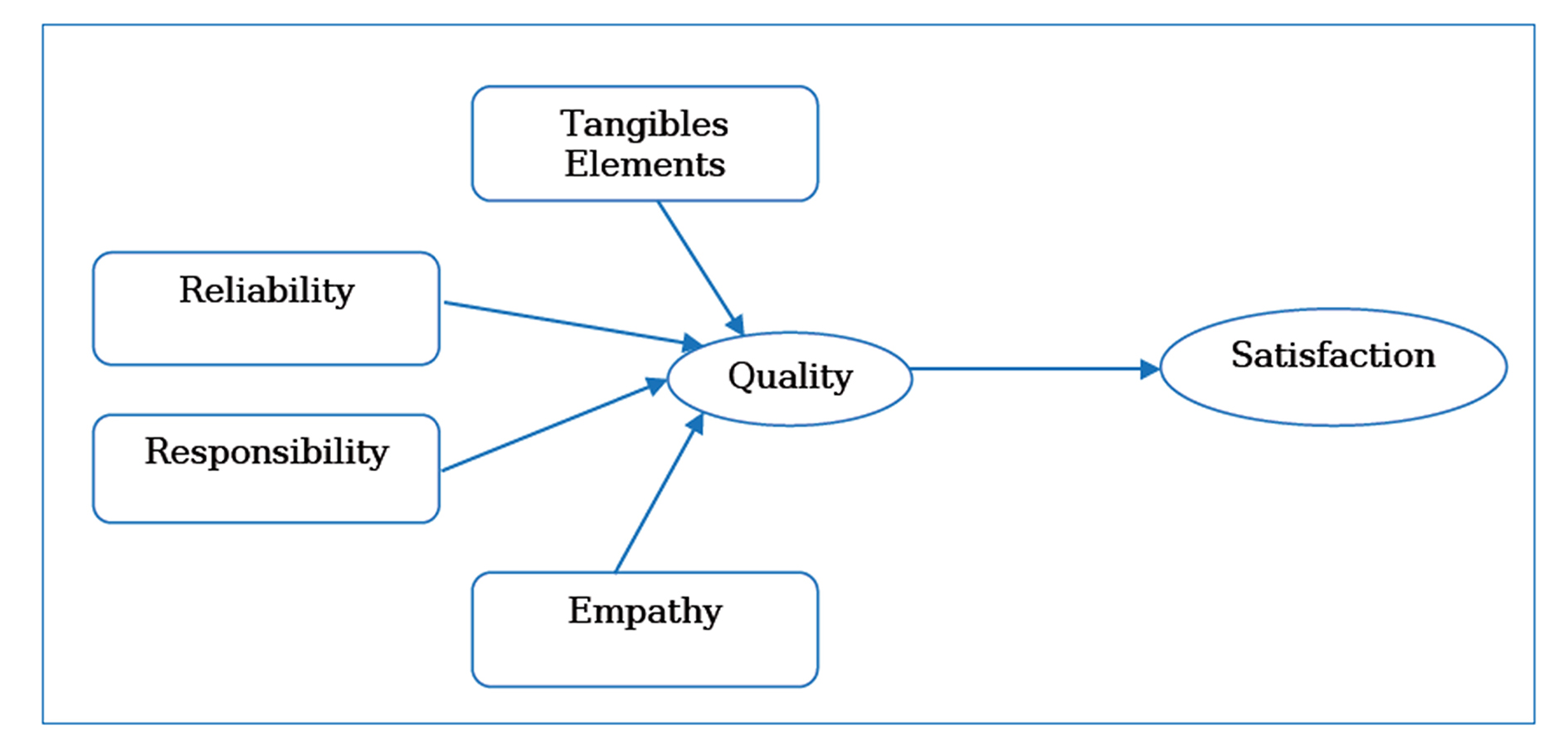
Figure 1. Conceptual model of the relationship between the quality of health services and user satisfaction. Source: Author own elaboration.
As a research question, the following has been stated: “How are service quality and users’ satisfaction related in the public health sector of the state of Tamaulipas, Mexico?” In order to give an to this question, it is necessary to identify the relationship of dependence that could be manifested between the dependent variable (satisfaction) and the independent variable (service quality). The multiple linear regression technique was applied from the following regression model.
Satisfaction = β0 + β1 (tangible elements) + β2 (reliability) + β3 (responsibility) + β4 (empathy) +ε
The results obtained in Table 2 made it possible to affirm that there is a significant linear relationship between quality’s latent factors and satisfaction variables (statistical F 1622, 118; Sig 0.000), indicating that 83.7% of the variation in satisfaction is explained by the set of quality factors, which according to Rojo (2007) are perceived as a good score level (values for R² from 0.5 to 0.85).
Specifically, it is possible to notice that when evaluating the relative importance of each independent variable in the regression equation, it is necessary to point out that the four quality factors (tangible elements, reliability, accountability and empathy) have coefficients different from zero (Beta values from .069 to .567), which concludes that all factors contribute significantly to explaining the dependent variable (Sig. = 0.000 to 0.001);being empathy the most important one at the sample level, followed by responsibility, reliability and finally tangible elements.
This is why, based on previous information and the analysis of the data obtained, the answer to the third research question is that the elements of the services’ quality and users’ satisfaction are positively and significantly related. Statistically, this means that user satisfaction in regard to the services they receive from APN, ASN, BSN, CSN, DSN, ATN, BTN and CTN hospitals is explained in 83.7% by their perception regarding the service’s quality, making evident the need to continuously improve the quality of the services offered to the population in order to raise the level of satisfaction of their beneficiaries. The higher the service quality is, the higher the level of patient satisfaction will be.
The results obtained in this study are findings that are reinforced by the contributions made by Correia and Miranda (2010), Amin and Zahora (2013), Kesuma, et al. (2013), who argues that quality is an element that proceeds transcendentally in the satisfaction of those who receive the health service. Similarly, the research conducted by Saad (2001) and Lee and Yom (2007) is also important evidence that gives strength to the results achieved in this research, leading to the conclusion that between the quality and satisfaction variables there is a significant association between their evaluation.
An important point to note is that according to the results obtained, tangible elements contributed the least value in the explanation of the model. This result is contrasted with the contribution made by Saad (2001) who determined in his inquiry that the discipline factor, which is an extension of the tangible dimension of SERVQUAL, is the most influential element in patient satisfaction, an argument that coincides with the results presented by Lee and Yom (2007) who identify in their research that the tangibility dimension represents the factor of greatest impact on the expectations and levels of satisfaction of the care process’s users. Probably the reason for these differences corresponds to the cultural level and financial scheme that health institutions have, as analyzed by Saad (2001) and Lee and Yom (2007), which are located in countries such as Korea and Bangladesh, where there is high quality equipment, facilities and up-to-date medical technology, causing patients to give greater importance to the evaluation of these components, in order to feel satisfied with the health services received from the public health system.
contrary to that, on the opposite side there is the empathy element, which from the values reached managed to provide the highest value in the regression coefficients, thus indicating that empathy is the factor that most influences the explanation of satisfaction, an assertion reinforced by the data obtained by Sánchez (2005), who, through the study carried out in medical institutions in Mexico, concludes that the elements of empathy, such as the care and kindness of health care providers, are the components that most influence the level of users’ satisfaction.
That is why the coincidence between these results is established probably due to the generalized culture of Mexican users towards the requirement of being treated nicely by health providers, making empathy the most impacting factor in their level of satisfaction, as determined in this study and the research carried out by Sánchez (2005).
5. Conclusions and recommendations
In the conclusion of this research, important points on the subject of interest are highlighted. In first instance, the importance that this issues has taken up in Mexico and other parts of the world is pointed out. Making this concept a priority for all institutions in different scenarios and economic sectors.
With regard to the public health system, the quality of medical care has been considered for over 50 years as one of the most strategic tools in hospital administration, by obliging health centers to provide timely and reliable services that satisfy the expectations and demands of an increasingly critical and demanding society on the services they receive.
In the area of health, quality is cataloged by several authors as a relevant component that precedes the satisfaction of the patients, thus representing a determining indicator for the care process. Given this scenario, evaluating hospital performance allows to identify the factors of success and areas of opportunity present within health institutions, since through its diagnosis it is possible to determine the way in which health services are performed and managed.
In the light of these theoretical arguments, in the present article the services’ quality assessment users’ satisfaction and the analysis on the relation between said variables of study were carried out under the view that analyzing both concepts and the influence exercised between them is for the theorists of the subject, this competitive advantage will allow the institution to efficiently develop its administrative processes in order to provide timely response to the requirements of the environment.
In this regard, the data presented shows that both, service quality and users’ satisfaction were evaluated with scores that are very close to a good perception by the respondents. It was also possible to verify that between the quality of the services and the satisfaction of the users there is a relationship of positive and significant dependence, which means that improving the service’s quality represents the starting point fto achieve the satisfaction of the users.
According to the analyzed results, achieving the satisfaction of health users depends to a great extent on the quality of the service provided and how it was managed. Since there is a good perception by the beneficiaries, statistically their level of satisfaction will be favored, as demonstrated by this research where both of the studied variables were rated with tendencies whose responses mainly rank between good and excellent.
In this context and because the essence of the research has shown that providing quality health services is indispensable for the satisfaction of the users it is adviced for public policy to carry out action plans focused on the training of medical and administrative staff in order to generate awareness and higher sensitivity towards the care provided to patients. Likewise, it is suggested to forge alliances among the hospitals of the area, with the intention of achieving a rational use of the health system’s biomedical infraestructure since those are detected as areas of opportunity in the study.
It is advisable for the authorities of health institutions to establish strategies for collaboration so as to allow them to maximize their resources (biomedical infrastructure) and capabilities (specialized human capital) for the benefit of health service users in order to guarantee an opportunity of attention and the service’s quality. The purpose is to address the public policies established for health services and, above all, to completely fulfill the needs and expectations of society.
Finally, it is considered necessary to carry out studies that determine the perception of users regarding the quality of health services and its relationship with their satisfaction in order to contribute to the development of new strategies that bring about good administrative practices in public medical institutions.













